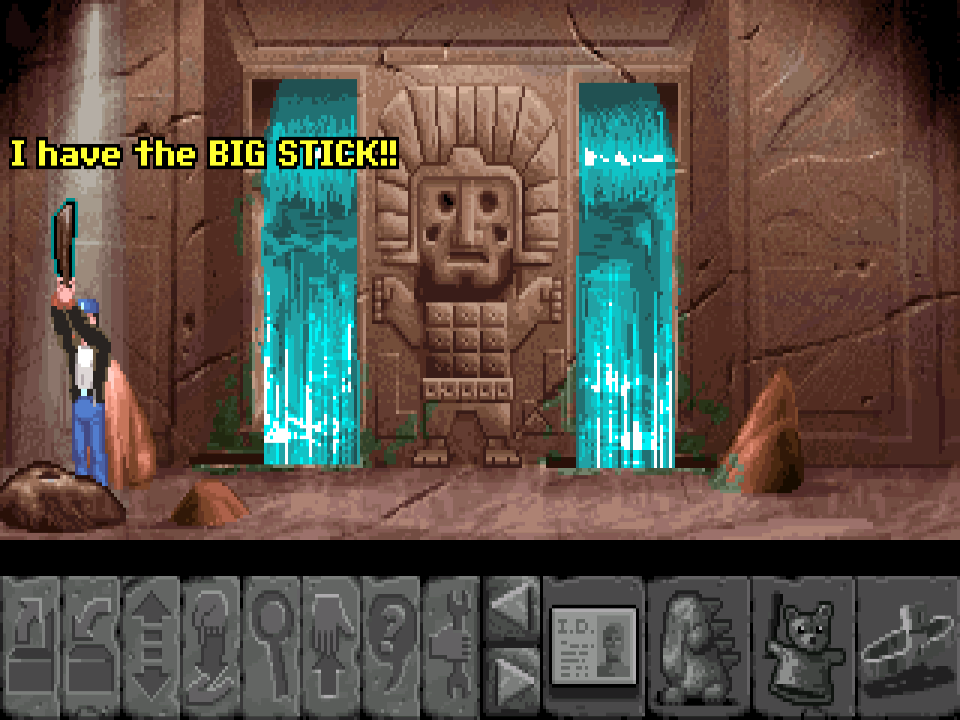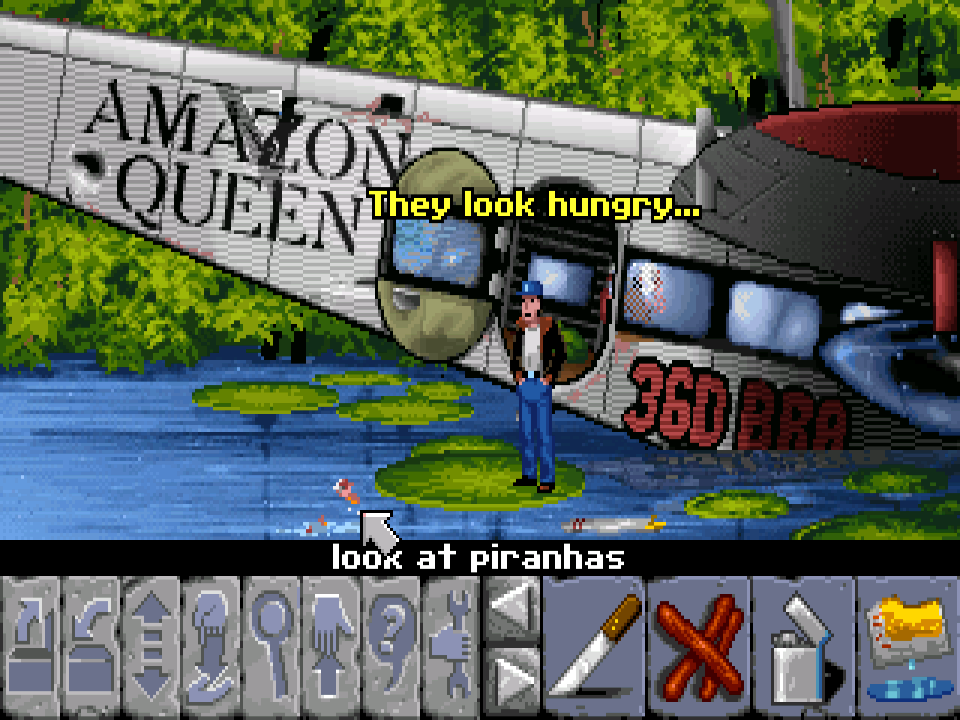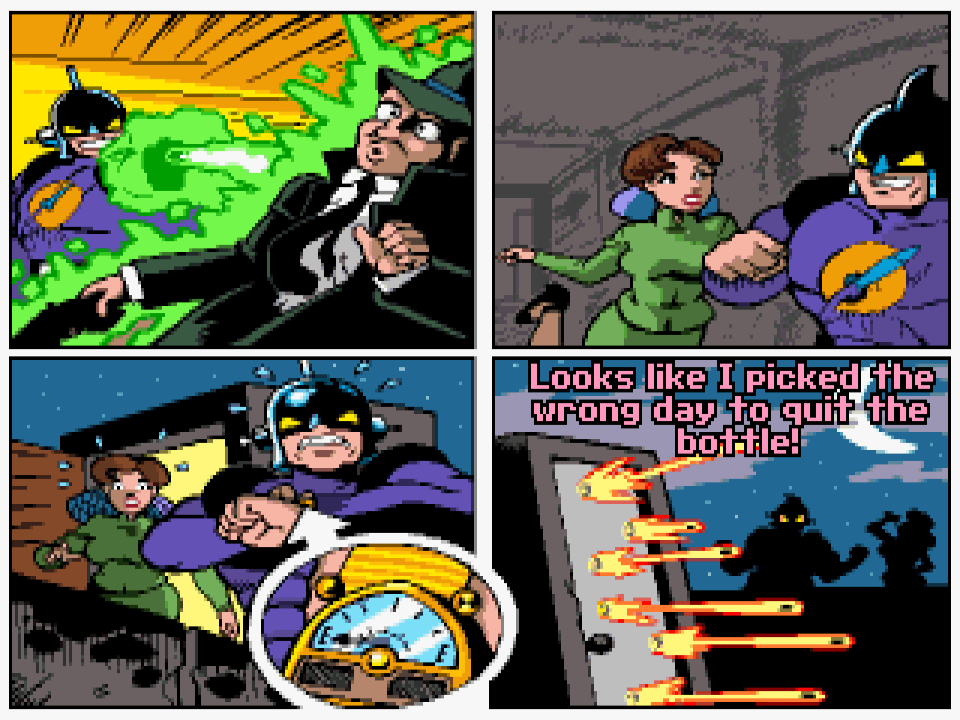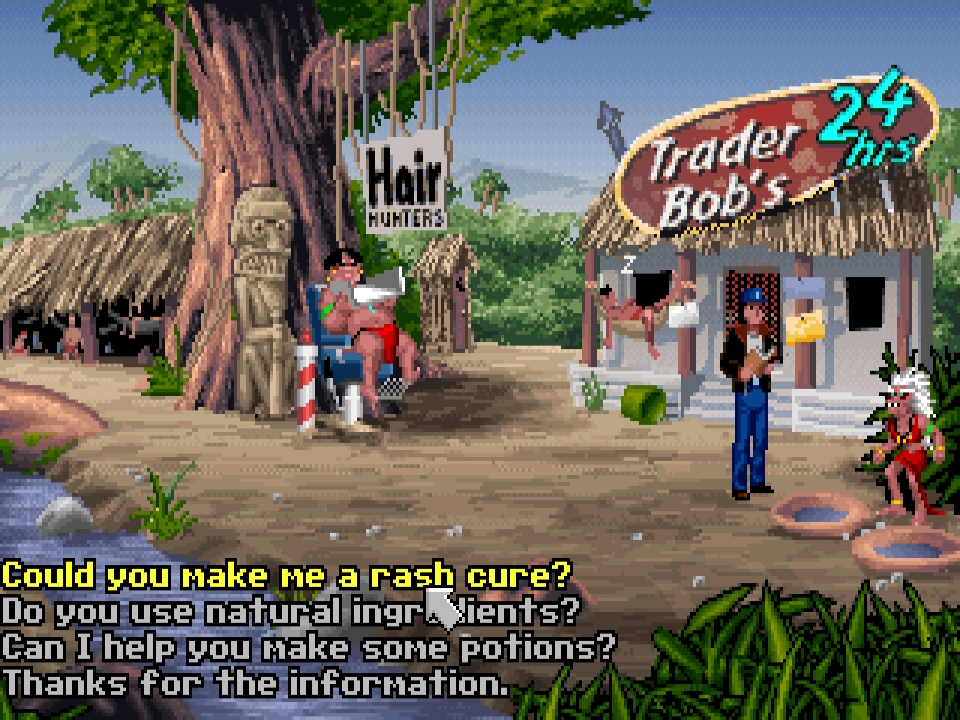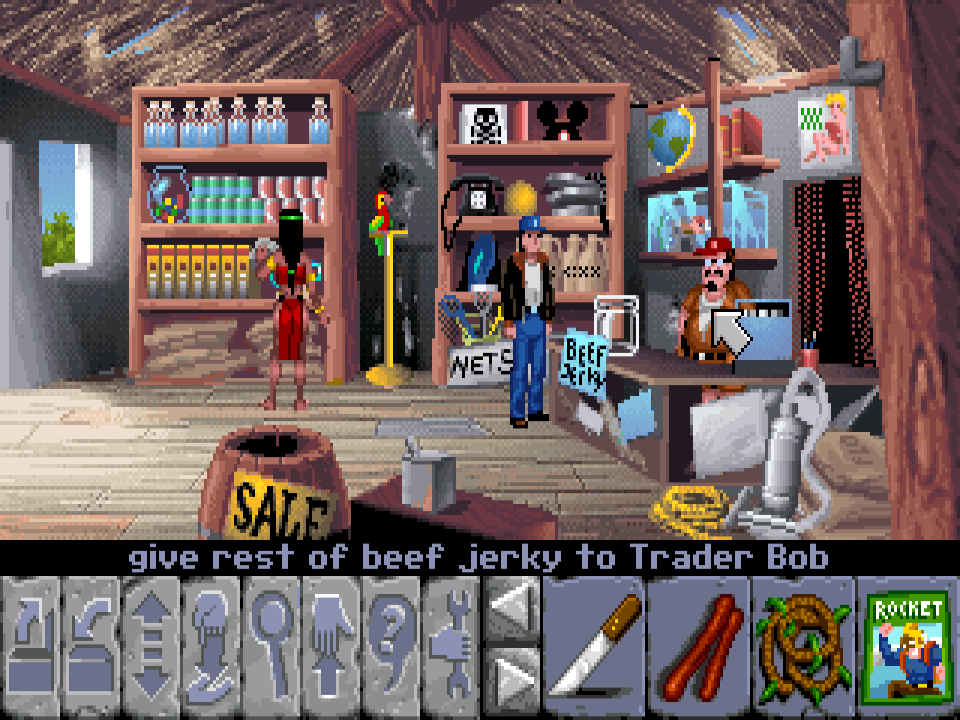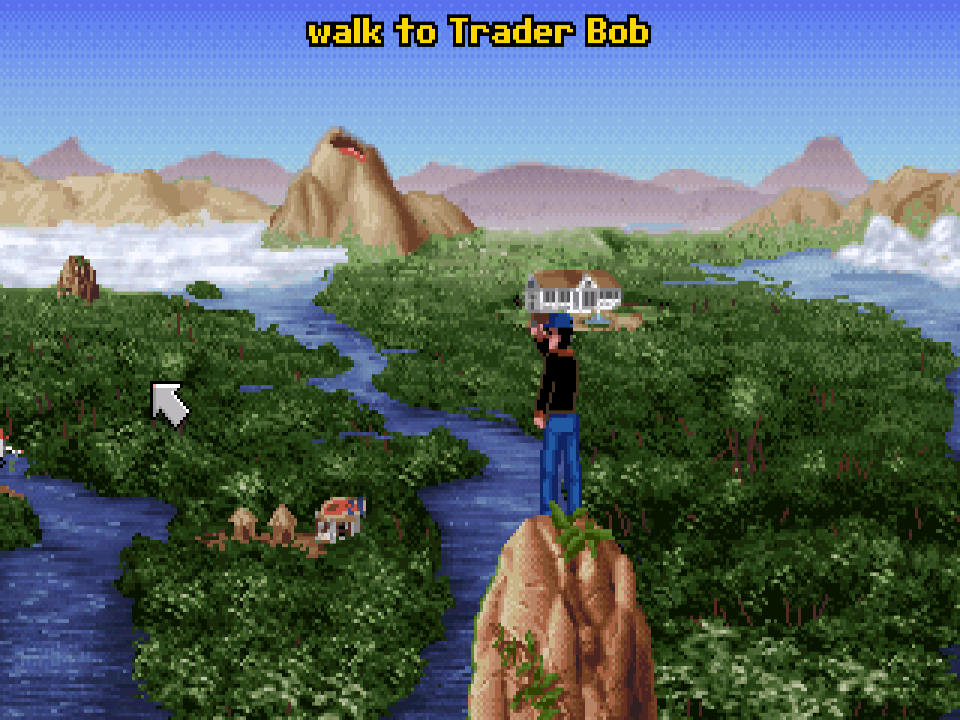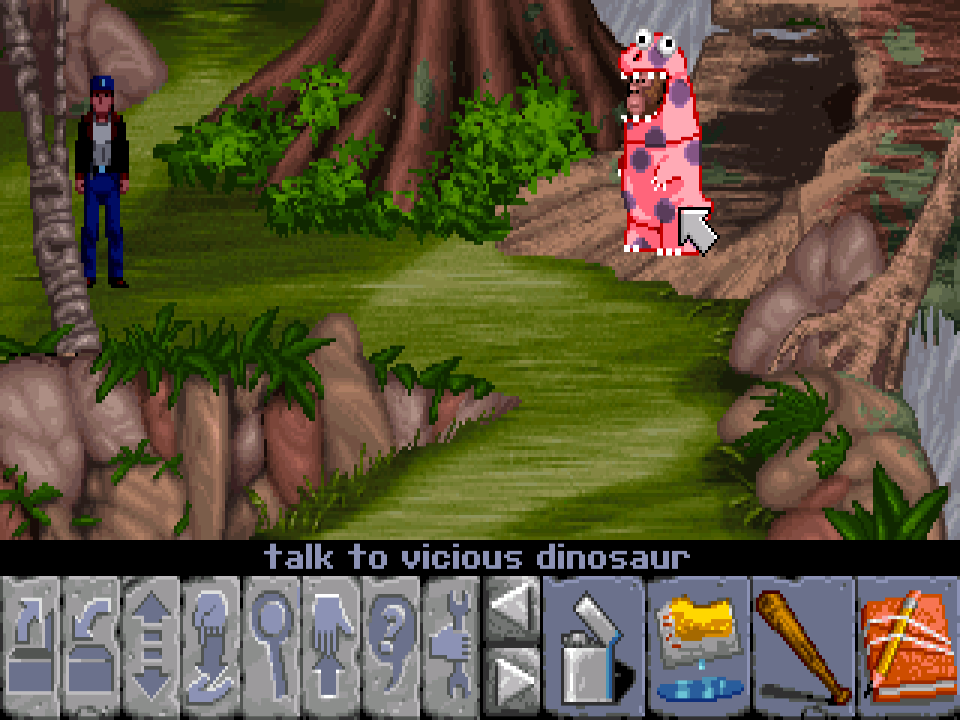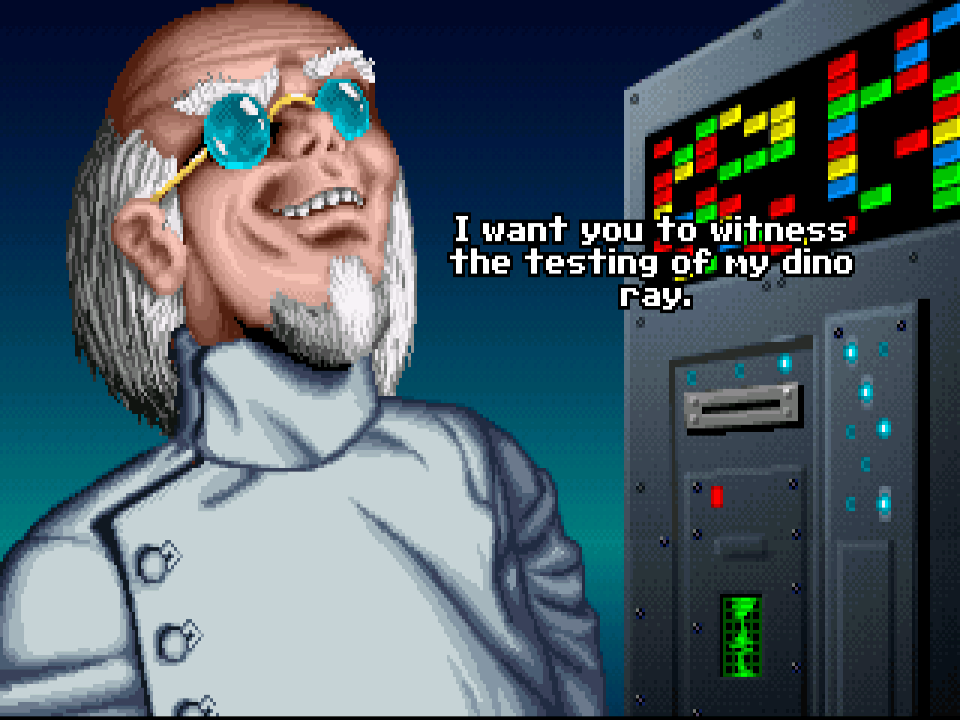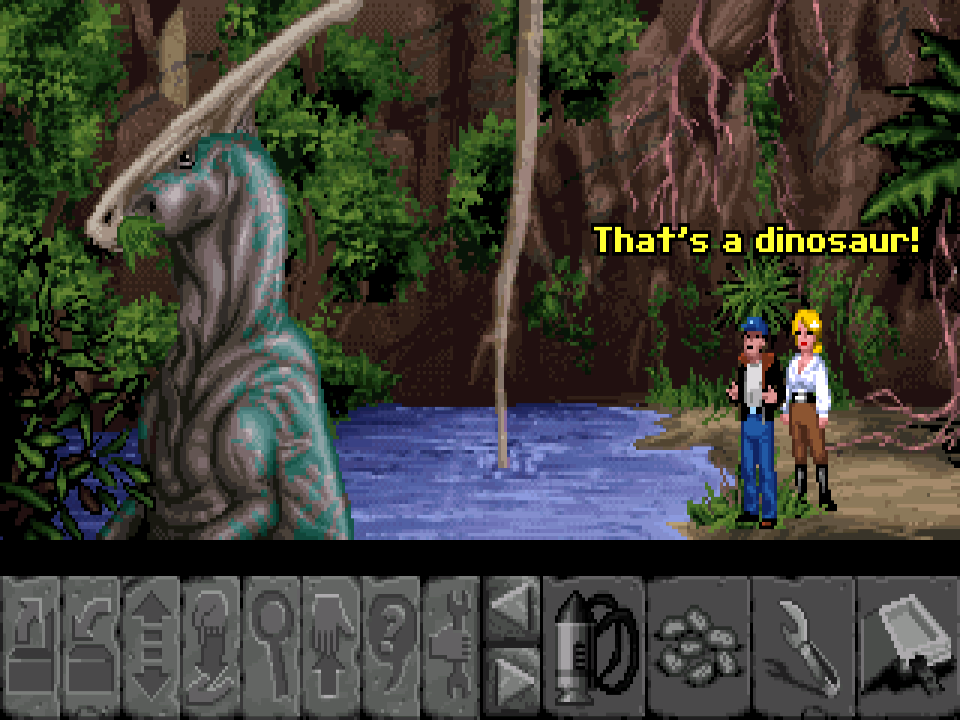Flight of the Amazon Queen (Interactive Binary Illusions) - 1995
Series: Let's Adventure! A Journey into Adventure Games (1980-1999)This review is part of the Let's Adventure! series. See all reviewed games sorted by rating here.
- ← Space Quest IV: Roger Wilco and the Time Rippers (Sierra On-Line) - 1991
- Flight of the Amazon Queen (Interactive Binary Illusions) - 1995
- → Altered Destiny (Accolade) - 1990
Article 80 of 101 in this series.
Flight of the Amazon Queen is a graphical point-and-click adventure game by Interactive Binary Illusions, originally released in 1995 for Amiga and MS-DOS.
Joe King is the hero of this point and click adventure. His plane is carrying actress Faye Russell when it crash lands in a remote jungle, and he must battle through 100 screens of adventure and puzzle. The game’s feel is influenced by hammy B-movies, and the characters are quite stereotyped and comic. As standard in point and click adventures, a set of icons at the bottom of the screen allow you to interact with visible characters and items in the main view area.1
 I’m shocked they don’t lean into this pun more often throughout the game
I’m shocked they don’t lean into this pun more often throughout the game
I’m a huge fan of LucasArts games, and after reading “Making of Flight of the Amazon Queen - A 20th Anniversary Retrospective” it seems that so was John Passfield. So many aspects of Flight of the Amazon Queen just smack of LucasArts’ influence, and the end result is a game that could easily live alongside classics such as The Secret of Monkey Island or Indiana Jones and the Fate of Atlantis.
Ron Gilbert and Tim Schafer’s influence on this game runs extremely deep. The comedic writing style, pixel art design, verb selection and dialog tree layout all feel reminiscent of a LucasArts title, and though they didn’t use the SCUMM engine, they’re custom game engine was titled JASPAR (John And Steve’s Programmable Adventure Resource) - which sort of feels like it belongs in that universe of tools with forced acronyms.
 Adding that “trademark” next to “comedy breasts” just screams of Monkey Island’s influence
Adding that “trademark” next to “comedy breasts” just screams of Monkey Island’s influence
Once the game starts you’ll find yourself locked in a hotel room that you need to escape. You’re a pilot for hire, and your next client is a famous movie star, but your rival Anderson wants to steal this job from you. To escape the hotel room you’ll need to use the various verbs represented as icons to LOOK, PICK UP and USE various things.
Most of this game involves inventory combination puzzles and fetch quests, so it’s worth examining everything on the screen to see if it’s something you can pick up, move, open/close or use.
This game is incredibly well paced, as long as you look at everything and talk to everyone. The path forward or solution to most puzzles is typically intuitive and when you need to combine items Joe will usually point you in the right direction.
When this gets a little more confusing is later in the game where you have a very large number of items - all of which you’ll need to use at some point (and often in combination).
The game likes to plant seeds as to the solution to puzzles through story elements. For example there is a brief sequence early in the game where you find a comic book that your mechanic Sparky is looking for. If you read the comic the hero uses alcohol to power is jetpack when it runs out of fuel so he can escape from the baddies just in the nick of time.
Amazingly enough, near the end of the game you find a jetpack - but it doesn’t have any fuel. Trader bob has bottles of alcohol for sale (but you need to prove you’re of age so you need ID to show him).
You’ll meet a number of characters throughout the Amazon that you’ll interact with. Most characters only really have one purpose and it’s typically (a) they’re preventing you from progressing or (b) they hold some inventory item you’ll need.
Each character has a limited number of dialog options, so it’s worth asking everyone about everything as it helps advance the plot and lays out what that character needs from you in fairly straightforward language.
Trader Bob is the exception as you’ll need to circle back to him multiple times to get new items. I did appreciate that though there are dozens of useable items in this game, none of them appear to be red herrings.
If an item will need to be used more than once, it will typically remain in your inventory in a depleted state to indicate it’s still needed. In my opinion this is better than the puzzle design in other games (notably a number of Sierra titles) where you have to backtrack to get an item again to use it as the solution to another puzzle.
Instead of the typical “map screen” you’d get in other games to navigate between game areas, Flight of the Amazon Queen has a pinnacle you walk to that overlooks the forest. From here you pan back and forth and can see the various locations you can travel to.
Technically it’s just a different take on the flat 2D map screen, but it’s also incorporated into the endgame as the location you need to launch from once you have the jetpack. Since you can’t travel back to the forest once you reach the Valley of the Mists it felt like a good way to tie the pinnacle you’ve been using for travel throughout the game into your journey towards the final encounter.
The game’s tone is extremely light and a little goofy. Joe King just feels and plays like a caricature of Indiana Jones, and they have a lot of fun with this. Every character you interact with doesn’t take themselves too seriously, and the underlying stories they’re presenting are enjoyable and keep you engaged.
I really like imaginary gorilla that pops up a couple of times blocking your path. Just talking to the gorilla and picking one of the dialog options that results in you questioning whether or not he should even exist will cause him to vanish.
As the game progresses you’ll be presented with static cut scenes that further advance the plot. It turns out there’s a mad scientist trying to capture Amazonian women so he can test a dino ray on them that turns them into dinosaurs.
I guess he wants to create an army of dino-humans and conquer the world … and you’re the only one that can stop him.
It’s kind of bananas that Joe King - a parody of Indiana Jones - needs to retrieve a crystal skull from the depths of the Amazon in order to activate an ancient robot, and over a decade later Indiana Jones and the Kingdom of the Crystal Skull did something sort of similar (but with aliens instead of ancient robots).
I know there’s almost no chance these two things are related, but in my mind I’m picturing David Koepp (who wrote the screenplay for that movie) walking by his kid playing FOTAQ in 1995 and thinking “that crystal skull looks neat” … then carrying on with his life.
If you play the MSDOS CD version of this game you’ll be treated to some fairly good voice acting. This enhances the game experience quite a bit as though there is some looping music in the background, it’s not really notable other than “being there”.
Bradley Lavelle who provides Joe’s voice does a fantastic job and really gives the character some depth. His delivery is a little dry and sarcastic, but suits Joe King perfectly.
Once you’ve got the crystal skull, Dr. Frank Ironstein will unlock the Valley of the Mists where all the dinosaurs live and you’ll need to get yourself over there for the final battle. This final sequence is pretty short (compared to the rest of the game) and just sees you defeating Monster Frank (the doctor gets zapped with his own dino ray), restoring the veil of mist to the Valley of the Mists and flying off into the sunset with Princess Azura.
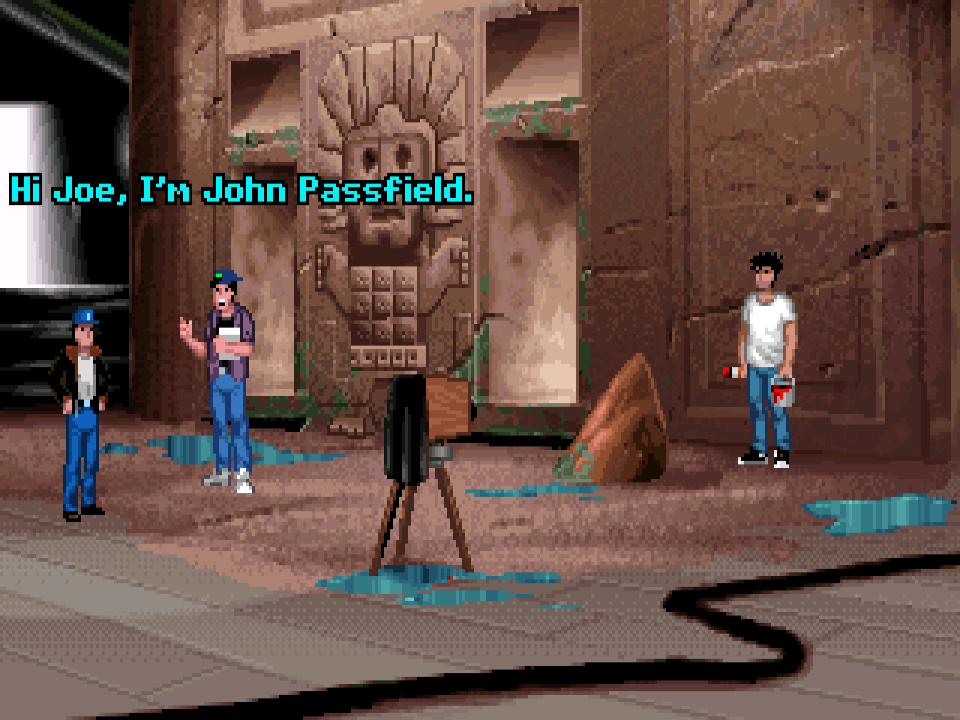 There’s a hidden mini-game on the CD version where you interview the game developers about the game you just played!
There’s a hidden mini-game on the CD version where you interview the game developers about the game you just played!
Discovering how much you can enjoy a game is the whole reason for a retrospective series like this, and Flight of the Amazon Queen is one such title. The story is immersive, the puzzles are challenging but intuitive, the graphics are great and the writing is entertaining.
This is definitely a game I’d recommend to anyone that may be interested in experiencing what the genre has to offer. It’s even more impressive knowing that only a handful of people worked on this game originally - and if you have the CD version of the game with the “INTERVIE” directory on it, you can play a minigame where you interview the developers of the game about the game you just played!
Flight of the Amazon Queen was re-released as freeware in 2004, and was incorporated into ScummVM as the fifth engine (they currently have A LOT of game engines). You can you can go download and enjoy the game right now!
Historical game preservation and ScummVM specifically are close to my heart so I want to close out this review with the following excerpt from “Beyond the Amiga: In Conversation with John Passfield on Flight of the Amazon Queen” as it shines a light on how this all came to be:
HS: Can you tell us about the involvement of ScummVM in making the game accessible today?
JP: I was approached from the ScummVM people and they were interested in making a version of Amazon Queen available through their online library of playable adventure games. I was aware at this point that new generation PCs that were coming out were making it harder to play Amazon Queen. And I thought, well, I own the intellectual property, so I made it freeware with the right that you download for free, but you couldn’t sell it. And I retained copyright ownership of the game and that’s when the ScummVM people come in. They reached out and said we’d love to convert Amazon Queen to the ScummVM engine. And I was that’d be great because then it lives on forever. So, they reached out and said can we do it? I said that would be great and a month later it’s available on ScummVM.
HS: ScummVM does not rely on the emulation of hardware. The ScummVM team uses a different process to make games playable on contemporary computing environments. Can you explain how they do this?
JP: I actually reached out to ScummVM on their Discord asking them how they went about it. What they explained is ScummVM is basically a framework for graphical programs which work with 2-D, and now 3-D, particularly with OpenGL. So, they provide middleware code which is called the OSystem. Then every game engine is ported to this middleware replacing or hardware dependent things like sound, graphical output, file reading, keyboard mouse input, times, et cetera, with a call to the OSystem. First off, they did this for the LucasArts Scumm engine. For my game they created the “Queen” engine. The Queen engine uses their middleware to interpret the game files for Amazon Queen. It’s completely different pieces of code having nothing in common with Scumm or any of the other four engines they had adapted at the time. Amazon Queen was the fifth engine they made compatible. They said because Amazon Queen had very little assembly, it was mostly C code, they said it was very easy to port over. And I think they’re obviously very smart people. So that’s how it came about and that is how it works. As mentioned, I believe they’ve got support now for the LucasArts games which have 3-D graphics.
I just love what they’re doing because it just gives that capacity to keep the game playable. It outputs at C++ so it works for everything. When Liron, who did the re-release of Amazon Queen for iOS in 2009, approached me to ask if he could port it into iOS he used the ScummVM Queen engine version and built on top of that engine extra stuff for the iOS version. The way that arrangement worked is that I granted him a licence to sell for iOS and he gave me a royalty. He has also put it on to the PC now. ScummVM just keeps these games accessible, which is great.
Game Information
| Game | Flight of the Amazon Queen |
| Developer | Interactive Binary Illusions |
| Publisher | Renegade Software |
| Release Date | 1995 |
| Systems | Amiga, DOS |
| Game Engine | JASPAR |
My Playthrough
| How Long To Beat? | 8 hours |
| Version Played | DOS CD via ScummVM |
| Notes | Walkthrough |
Score
See here for a refresher on how we’re scoring these games.
| Atmosphere (20) | 16 |
| Story (25) | 21 |
| Experience (15) | 13 |
| Impact (10) | 9 |
| 84% |
Gallery
Footnotes
Description from Moby Games ↩︎


